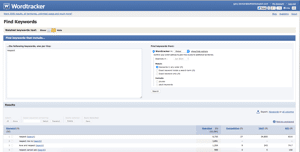Tips on Doing Research About Keywords
Spending time doing research about keywords is one of the most important activities you can do to increase traffic. Good keyword research and selection will help you drive more traffic and make more money. It will also give you valuable insight into the digital behavior of your customers as a whole. Which in turn will make you a better marketer.
Truth is – effective online marketing is not always about getting a huge traffic to your site. It is about getting the right kind of traffic. The insight digital marketers can get when doing keyword research helps them to better communicate their product or service offerings to a well defined target audience. It can also help them find less competitive niches in saturated markets as well as help them predict shifts in demand and respond to changing market conditions.
Choosing the keyword phrase you want to optimize for on a Web page can be extremely challenging. There are a limitless number of keywords and keyword phrase variations you can use. Choosing the right one is be very difficult if you do not have a strategy you can follow.
Thankfully, the science of keyword researching is well documented, so we have identified number effective steps you can take when investing time doing research about keywords.
Here is a quick overview of the process:
Three Steps to Doing Research About Keywords
Step 1. Create an initial seed list.
When doing research about keywords start with building an initial list of keyword ideas. You can start with a list of five or six keywords in order to jump start your keyword research. Remember to be as comprehensive as you can in terms of capturing the benefits of your product or service. After all, if you possess a good understanding of your target audience and have clearly identified your company or product’s unique selling proposition (USP), shortlisting an initial keyword list will be a piece of cake.
In addition, keep in mind that keywords are important not only for search engine optimization, but for the development of your overall content strategy. Consistency is key in maximizing your online advertising efforts.
Step 2. Expand your keyword list.
You can expand your keyword list with the help of keyword research tools such as the Google AdWords Keyword Research available online or wordtracker.com.
Once you begin the keyword research process, your research tool will be able to give you a list of related keywords to consider. This allows you to expand your keyword list to include new keywords and phrases that are relevant to your consumers’ pain points and needs.
Here are two helpful tips on how to use the tool effectively:
- Select ‘Exact Match Type’. Exact Match will give you the number of searches for a specific term only. It provides digital marketers with the most realistic estimate of the search traffic.
- Under Advanced Options and Filters, select the language and location you’re interested in. By making use of such filters, you can get an even more accurate estimate of the search volume from an audience matching your criteria.

Step 3. Refine your keyword list.
Now that you have a good list of keywords, it’s time to focus only on the most resonating keywords. This is especially important if you’re developing a keyword list for search engine optimization (SEO) purposes.
Competition is a big factor that you should keep in mind when refining your keyword list. It is important to identify how many webpages are specifically targeting the keywords you intend to use. If you find that a large number of companies and brands are actively trying to rank for that term, you will have a harder time ranking well for that keyword.
As a basic rule, stick with the keywords that are high in popularity and relatively low in competition. Also, do not ignore long tailed keywords. Click for our article on long tail keywords.